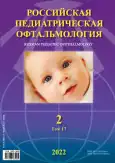Хронический односторонний передний узелковый склерит с локальным поражением цилиарного тела, ассоциированный с вирусом варицелла-зостер
- Авторы: Ковалева Л.А.1, Кричевская Г.И.1, Давыдова Г.А.1, Зайцева А.А.1
-
Учреждения:
- НМИЦ глазных болезней им. Гельмгольца
- Выпуск: Том 17, № 2 (2022)
- Страницы: 31-38
- Раздел: Клинические случаи
- URL: https://journals.rcsi.science/1993-1859/article/view/105641
- DOI: https://doi.org/10.17816/rpoj105641
- ID: 105641
Цитировать
Аннотация
Цель. Анализ этиопатогенеза, клинических особенностей и терапии хронического одностороннего переднего узелкового склерита с локальным поражением цилиарного тела с целью повышения врачебной настороженности к герпетической этиологии заболевания при отсутствии экстраокулярных проявлений герпетической инфекции, сокращения продолжительности заболевания и повышения эффективности лечения.
Результаты. Проведён анализ особенностей этиопатогенеза, описаны характерные клинические симптомы хронического узелкового склерита, локального переднего циклита и парспланита, вызванных вирусом варицелла-зостер (Varicella-Zoster virus, VZV). Этиологическая роль VZV установлена на основании высокого уровня VZV-IgG-антител, наличия VZV-gE-IgG антител (маркёров активной репликации вируса), эффективности противогерпетической терапии.
Обсуждение. Хирургическое удаление меланоцитарного невуса кожи с аутотрансплантацией кожи в параорбитальной области левого глаза, в зоне иннервации первой ветви тройничного нерва, способствовало реактивации офтальмогерпеса и развитию переднего узелкового склерита левого глаза. Интенсивная длительная неэффективная терапия кортикостероидами и антибактериальными лекарственными средствами в отсутствии этиотропного лечения вызвала хроническое течение переднего узелкового склерита, распространение воспалительного процесса на цилиарное тело, развитие локального переднего циклита и парспланита герпетической этиологии у больного 17 лет.
Заключение. Требуется максимальная врачебная настороженность, ранняя и точная клиническая дифференциальная диагностика между склеритами, связанными с иммуновоспалительными ревматическими заболеваниями и герпесвирусными инфекциями. Следует учитывать, что расширение спектра и количества используемых противовоспалительных лекарственных средств при отсутствии положительной динамики от их применения приводит к хроническому течению заболевания. Неадекватное лечение может привести к распространению воспаления на глубоко лежащие оболочки глазного яблока, снижению остроты зрения; нежелательным эффектам местной глюкокортикоидной терапии, например, к повышению внутриглазного давления и развитию катаракты.
При любом склерите, устойчивом к общепринятому лечению, необходимо учитывать вероятность герпетической этиологии воспалительного процесса и проведение лабораторной диагностики офтальмогерпеса. В случае отсутствия специализированной лаборатории с целью этиологической диагностики необходимо рассмотреть возможность проведения противовирусной терапии ex juvantibus.
Описанные нами клинические симптомы хронического узелкового склерита с локальным поражением цилиарного тела способствуют ранней диагностике офтальмогерпеса. Своевременно поставленный диагноз позволяет начать противовирусную терапию с противогерпетическим эффектом, предупредив развитие хронического течения заболевания, возникновения осложнений и сохранения и/или восстановления остроты зрения.
Полный текст
Открыть статью на сайте журналаОб авторах
Людмила Анатольевна Ковалева
НМИЦ глазных болезней им. Гельмгольца
Автор, ответственный за переписку.
Email: ulcer.64@mail.ru
ORCID iD: 0000-0001-6239-9553
SPIN-код: 1406-5609
кандидат медицинских наук
Россия, МоскваГалина Исааковна Кричевская
НМИЦ глазных болезней им. Гельмгольца
Email: ulcer.64@mail.ru
ORCID iD: 0000-0001-7052-3294
SPIN-код: 6808-0922
кандидат медицинских наук
Россия, МоскваГалина Анатольевна Давыдова
НМИЦ глазных болезней им. Гельмгольца
Email: ulcer.64@mail.ru
ORCID iD: 0000-0003-4215-7084
SPIN-код: 4895-7983
кандидат медицинских наук
Россия, МоскваАлина Андреевна Зайцева
НМИЦ глазных болезней им. Гельмгольца
Email: ulcer.64@mail.ru
ORCID iD: 0000-0001-8852-3305
врач-офтальмолог
Россия, МоскваСписок литературы
- Akpek E.K., Thorne J.E., Qazi F.A., et al. Evaluation of patients with scleritis for systemic disease // Ophthalmology. 2004. Vol. 111, N 3. P. 501–506. doi: 10.1016/j.ophtha.2003.06.006
- Okhravi N., Odufuwa B., McCluskey P., Lightman S. Scleritis // Surv Ophthalmol. 2005. Vol. 50, N 4. P. 351–363. doi: 10.1016/j.survophthal.2005.04.001
- Sainz de la Maza M., Molina N., Gonzalez-Gonzalez L.A., et al. Clinical characteristics of a large cohort of patients with scleritis and episcleritis // Ophthalmology. 2012. Vol. 119, N 1. P. 43–50. doi: 10.1016/j.ophtha.2011.07.013
- Homayounfar G., Nardone N., Borkar D.S., et al. Incidence of scleritis and episcleritis: results from the Pacific Ocular Inflammation Study // Am J Ophthalmol. 2013. Vol. 156, N 4. P. 752–758. doi: 10.1016/j.ajo.2013.05.026
- Watson P.G., Hayreh S.S. Scleritis and episcleritis // Br J Ophthalmol. 1976. Vol. 60, N 3. P. 163–191. doi: 10.1136/bjo.60.3.163
- Wieringa W.G., Wieringa J.E., ten Dam-van Loon N.H., Los L.I. Visual outcome, treatment results, and prognostic factors in patients with scleritis // Ophthalmology. 2013. Vol. 120, N 2. P. 379–386. doi: 10.1016/j.ophtha.2012.08.005
- Akintayo R.O., Adelowo O.O., Egajifo O., et al. The impact of ocular manifestations of rheumatoid arthritis on the health-related quality of life and the functional ability of black Africans // Int Ophthalmol. 2019. Vol. 39, N 5. P. 1003–1012. doi: 10.1007/s10792-018-0902-6
- Sharma S.M., Damato E., Hinchcliffe A.E., et al. Long-term efficacy and tolerability of TNFalpha inhibitors in the treatment of non-infectious ocular inflammation: an 8-year prospective surveillance study // Br J Ophthalmol. 2021. Vol. 105, N 9. P. 1256–1262. doi: 10.1136/bjophthalmol-2018-312767
- Sainz de la Maza M., Molina N., Gonzalez-Gonzalez L.A., et al. Scleritis therapy // Ophthalmology. 2012. Vol. 119, N 1. P. 51–58. doi: 10.1016/j.ophtha.2011.07.043
- Heron E., Bourcier T. [Scleritis and episcleritis] // J Fr Ophtalmol. 2017. Vol. 40, N 8. P. 681–695. (In French). doi: 10.1016/j.jfo.2017.04.007
- Gonzalez-Gonzalez L.A., Molina-Prat N., Doctor P., et al. Clinical features and presentation of infectious scleritis from herpes viruses: a report of 35 cases // Ophthalmology. 2012. Vol. 119, N 7. P. 1460–1464. doi: 10.1016/j.ophtha.2012.01.033
- Loureiro M., Rothwell R., Fonseca S. Nodular Scleritis Associated with Herpes Zoster Virus: An Infectious and Immune-Mediated Process // Case Rep Ophthalmol Med. 2016. Vol. 2016, N. P. 8519394. doi: 10.1155/2016/8519394
Дополнительные файлы












